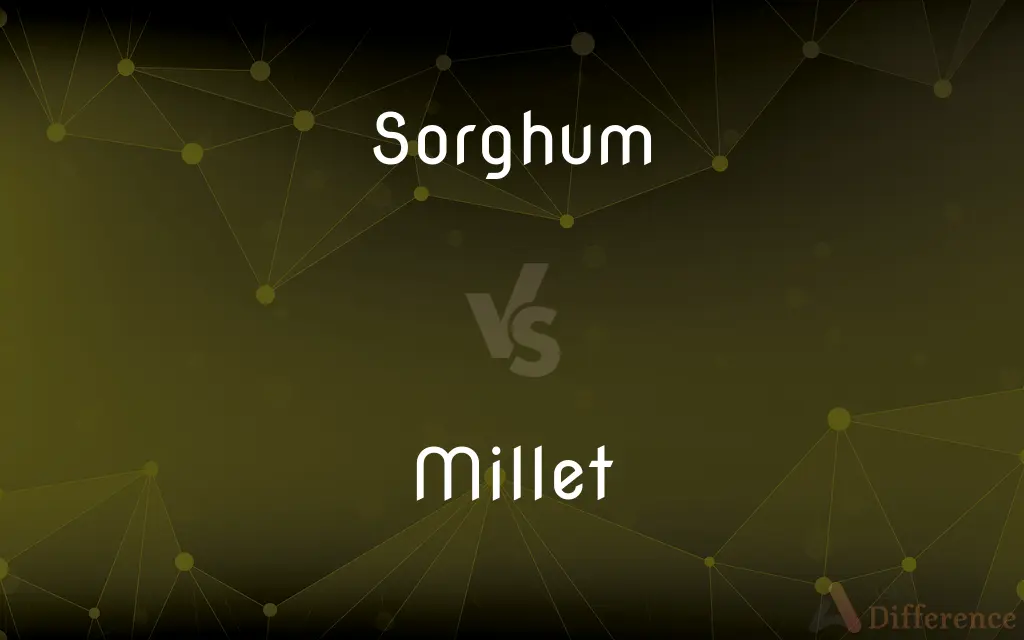Sorghum vs. Millet — What's the Difference?
By Tayyaba Rehman — Updated on September 5, 2023
Sorghum is a cereal grain primarily used for food and fodder, while millet encompasses a group of small-seeded grains consumed worldwide. Both are drought-tolerant crops.

Difference Between Sorghum and Millet
Table of Contents
ADVERTISEMENT
Key Differences
Sorghum and millet are both ancient grains that have been cultivated for thousands of years, especially in arid regions. Sorghum, known scientifically as Sorghum bicolor, stands tall and is often grown for its grain and as a forage plant. In contrast, millet represents a variety of smaller-seeded cereal crops, each with its own species and characteristics.
Diving deeper, sorghum grains tend to be larger and are often used in foods such as porridges, bread, and syrups. Millet, on the other hand, consists of multiple species like pearl, finger, and proso millet. These grains are widely consumed in various parts of the world in dishes ranging from flatbreads to fermented beverages.
In agricultural terms, both sorghum and millet have the advantage of being highly drought-resistant. This makes them vital crops in regions with unpredictable rainfall. While both are staple foods in many areas, sorghum also finds its place in the industrial world, being used in the production of alcoholic beverages and biofuels, whereas millet remains predominantly a food crop.
Nutritionally, both sorghum and millet are gluten-free grains, making them excellent alternatives for those with gluten sensitivities. While they share this trait, their nutrient profiles differ slightly, with sorghum being rich in antioxidants and millet being a good source of magnesium and fiber.
Comparison Chart
Species Name
Sorghum bicolor
Various (e.g., Panicum miliaceum for Proso Millet)
ADVERTISEMENT
Grain Size
Larger grains
Smaller seeds
Uses
Food, fodder, alcoholic beverages, biofuels
Predominantly food (e.g., bread, porridge)
Cultivation
Grown globally, especially in arid regions
Grown worldwide with specific types in specific regions
Nutritional Benefits
Rich in antioxidants
Good source of magnesium and fiber
Compare with Definitions
Sorghum
A tall cereal grain plant cultivated for its grain and forage.
Farmers have cultivated sorghum for thousands of years because of its drought resistance.
Millet
A group of small-seeded cereal grains consumed globally.
Millet has been a staple in India for centuries.
Sorghum
Also utilized in industrial applications like biofuel production.
The increasing demand for biofuels has boosted sorghum cultivation in recent years.
Millet
Known for being drought-resistant and hardy.
In arid regions, millet thrives where other crops fail.
Sorghum
Used in human consumption, especially in traditional dishes.
Sorghum porridge is a common breakfast dish in many African countries.
Millet
A significant source of dietary magnesium and fiber.
Consuming millet regularly can contribute to a balanced diet.
Sorghum
Rich in nutrients and free from gluten.
Those with celiac disease can safely consume sorghum-based products.
Millet
Used in diverse dishes, from bread to beverages.
In some cultures, millet is fermented to produce traditional drinks.
Sorghum
Often used as animal fodder, especially in dry regions.
When the rains failed, farmers fed sorghum to their livestock.
Millet
Often ground into flour for gluten-free cooking and baking.
Bakers use millet flour to create gluten-free bread that's both tasty and nutritious.
Sorghum
Sorghum is a genus of about 25 species of flowering plants in the grass family (Poaceae). Some of these species are grown as cereals for human consumption and some in pastures for animals.
Millet
Millets () are a group of highly variable small-seeded grasses, widely grown around the world as cereal crops or grains for fodder and human food. Millets are important crops in the semiarid tropics of Asia and Africa (especially in India, Mali, Nigeria, and Niger), with 97% of millet production in developing countries.
Sorghum
A cereal which is native to warm regions of the Old World and is a major source of grain and stockfeed.
Millet
A cereal grown in warm countries and regions with poor soils, bearing a large crop of small seeds which are chiefly used to make flour.
Sorghum
A cultivated grass (Sorghum bicolor) native to sub-Saharan Africa, several varieties of which are widely grown for their grain, as forage, or as a source of syrup.
Millet
Any of various annual grasses with small grains that are harvested for food, livestock feed, and birdseed, especially proso millet.
Sorghum
Syrup made from the juice of this plant.
Millet
The grains of any of these plants.
Sorghum
A cereal, Sorghum genus and species, the grains of which are cultivated to make flour and feed cattle. Almost all cultivated ones as well as some wild ones belong to the species Sorghum bicolor (syn. Sorghum vulgare).
Millet
A demographic group in the Ottoman Empire, defined in terms of religious affiliation and enjoying a degree of legal autonomy.
Sorghum
(Southern US) Sorghum syrup.
Millet
Any of a group of various types of grass or its grains used as food, widely cultivated in the developing world.
Sorghum
A genus of grasses, properly limited to two species, Sorghum Halepense, the Arabian millet, or Johnson grass (see Johnson grass), and S. vulgare, the Indian millet (see Indian millet, under Indian).
Millet
(specifically) common millet, in particular Panicum miliaceum.
Sorghum
Economically important Old World tropical cereal grass
Millet
(historical) A semi-autonomous confessional community under the Ottoman Empire, especially a non-Muslim one.
Sorghum
Made from juice of sweet sorghum
Millet
The name of several cereal and forage grasses which bear an abundance of small roundish grains. The common millets of Germany and Southern Europe are Panicum miliaceum, and Setaria Italica.
Millet
Any of various small-grained annual cereal and forage grasses of the genera Panicum, Echinochloa, Setaria, Sorghum, and Eleusine
Millet
French painter of rural scenes (1814-1875)
Millet
Small seed of any of various annual cereal grasses especially Setaria italica
Common Curiosities
What are Sorghum and Millet?
Sorghum is a tall cereal grain, while millet refers to several small-seeded cereal crops.
Can both Sorghum and Millet be used for baking?
Yes, both grains can be ground into flour and used in gluten-free baking.
Which grain is larger, Sorghum or Millet?
Sorghum grains are generally larger than millet seeds.
Which is more drought-resistant, Sorghum or Millet?
Both are highly drought-resistant, making them essential in arid regions.
Which has a broader range of species, Sorghum or Millet?
Millet encompasses a wider variety of species compared to sorghum.
Are both Sorghum and Millet gluten-free?
Yes, both grains are naturally gluten-free.
Where are Sorghum and Millet primarily grown?
Both are grown globally, especially in regions with limited rainfall.
Is Sorghum a type of Millet?
No, they are distinct grains, though both are ancient and drought-resistant.
Which is more versatile in cooking, Sorghum or Millet?
Both are versatile, but millet might have a slight edge due to its variety of species and uses.
How are Sorghum and Millet consumed?
Sorghum is used in porridges, syrups, and bread, while millet is consumed in bread, porridges, and beverages.
Is Sorghum used in industrial applications?
Yes, sorghum is used in the production of alcoholic beverages and biofuels.
What are the nutritional benefits of Millet?
Millet is a good source of magnesium and fiber.
Which is older in terms of cultivation, Sorghum or Millet?
Both have ancient origins, with evidence of cultivation going back thousands of years.
Are there any allergenic concerns with Sorghum or Millet?
While rare, some people might be allergic, but both are safe for gluten-sensitive individuals.
Can Sorghum and Millet be interchangeably used in recipes?
They can often be substituted for each other, but textures and flavors may vary.
Share Your Discovery

Previous Comparison
Typewriters vs. Keyboard
Next Comparison
Fisher vs. WolverineAuthor Spotlight
Written by
Tayyaba RehmanTayyaba Rehman is a distinguished writer, currently serving as a primary contributor to askdifference.com. As a researcher in semantics and etymology, Tayyaba's passion for the complexity of languages and their distinctions has found a perfect home on the platform. Tayyaba delves into the intricacies of language, distinguishing between commonly confused words and phrases, thereby providing clarity for readers worldwide.















































